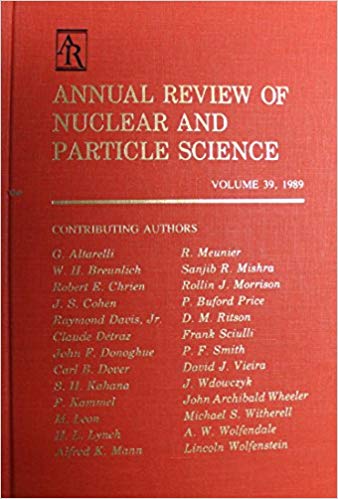核物理和天体物理学中的协变密度泛函理论
IF 8.4
2区 物理与天体物理
Q1 PHYSICS, NUCLEAR
Annual Review of Nuclear and Particle Science
Pub Date : 2019-12-23
DOI:10.1146/annurev-nucl-101918-023608
引用次数: 20
摘要
亚原子物质是如何组织自身的?中子星是宇宙实验室,能够回答核科学核心的这一基本问题。新委托使用的稀有同位素设施、在整个电磁波谱上运行的望远镜以及越来越灵敏的引力波探测器将在巨大的密度范围内以前所未有的精度探测富含中子的物质的性质。观察、实验和理论研究之间的协调努力对于充分发挥这些投资的潜力至关重要。理论核物理学为目前无法进行实验或观测的富含中子物质的性质提供了有价值的见解。特别是,核密度泛函理论可能是唯一一个可以通过将有限的核与中子星连接起来来连接整个核景观的可处理框架。这种令人信服的联系是本审查的主要范围。本文章由计算机程序翻译,如有差异,请以英文原文为准。
Covariant Density Functional Theory in Nuclear Physics and Astrophysics
How does subatomic matter organize itself? Neutron stars are cosmic laboratories uniquely poised to answer this fundamental question that lies at the heart of nuclear science. Newly commissioned rare isotope facilities, telescopes operating across the entire electromagnetic spectrum, and ever more sensitive gravitational wave detectors will probe the properties of neutron-rich matter with unprecedented precision over an enormous range of densities. A coordinated effort between observation, experiment, and theoretical research is of paramount importance for realizing the full potential of these investments. Theoretical nuclear physics provides valuable insights into the properties of neutron-rich matter in regimes that are not presently accessible to experiment or observation. In particular, nuclear density functional theory is likely the only tractable framework that can bridge the entire nuclear landscape by connecting finite nuclei to neutron stars. This compelling connection is the main scope of the present review.
求助全文
通过发布文献求助,成功后即可免费获取论文全文。
去求助
来源期刊
CiteScore
21.50
自引率
0.80%
发文量
18
期刊介绍:
The Annual Review of Nuclear and Particle Science is a publication that has been available since 1952. It focuses on various aspects of nuclear and particle science, including both theoretical and experimental developments. The journal covers topics such as nuclear structure, heavy ion interactions, oscillations observed in solar and atmospheric neutrinos, the physics of heavy quarks, the impact of particle and nuclear physics on astroparticle physics, and recent advancements in accelerator design and instrumentation.
One significant recent change in the journal is the conversion of its current volume from gated to open access. This conversion was made possible through Annual Reviews' Subscribe to Open program. As a result, all articles published in the current volume are now freely available to the public under a CC BY license. This change allows for greater accessibility and dissemination of research in the field of nuclear and particle science.

 求助内容:
求助内容: 应助结果提醒方式:
应助结果提醒方式:


